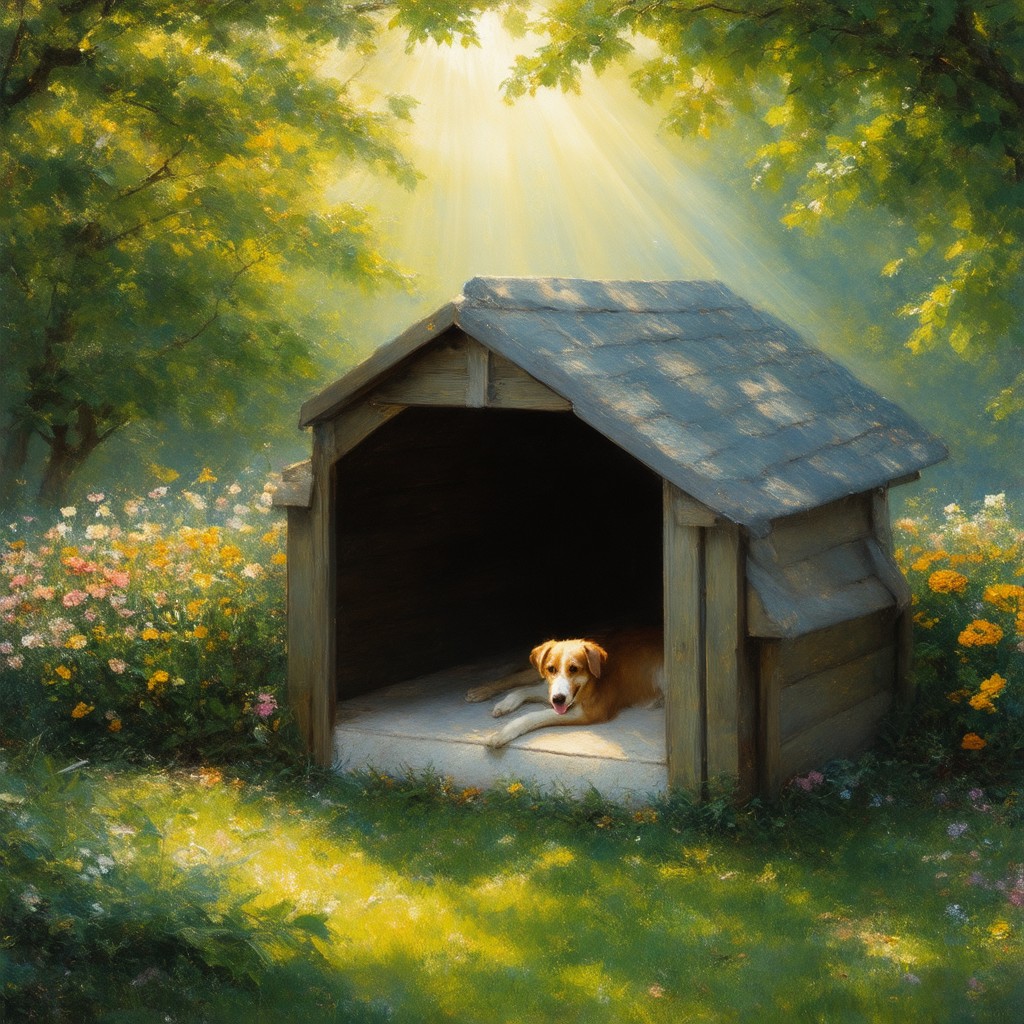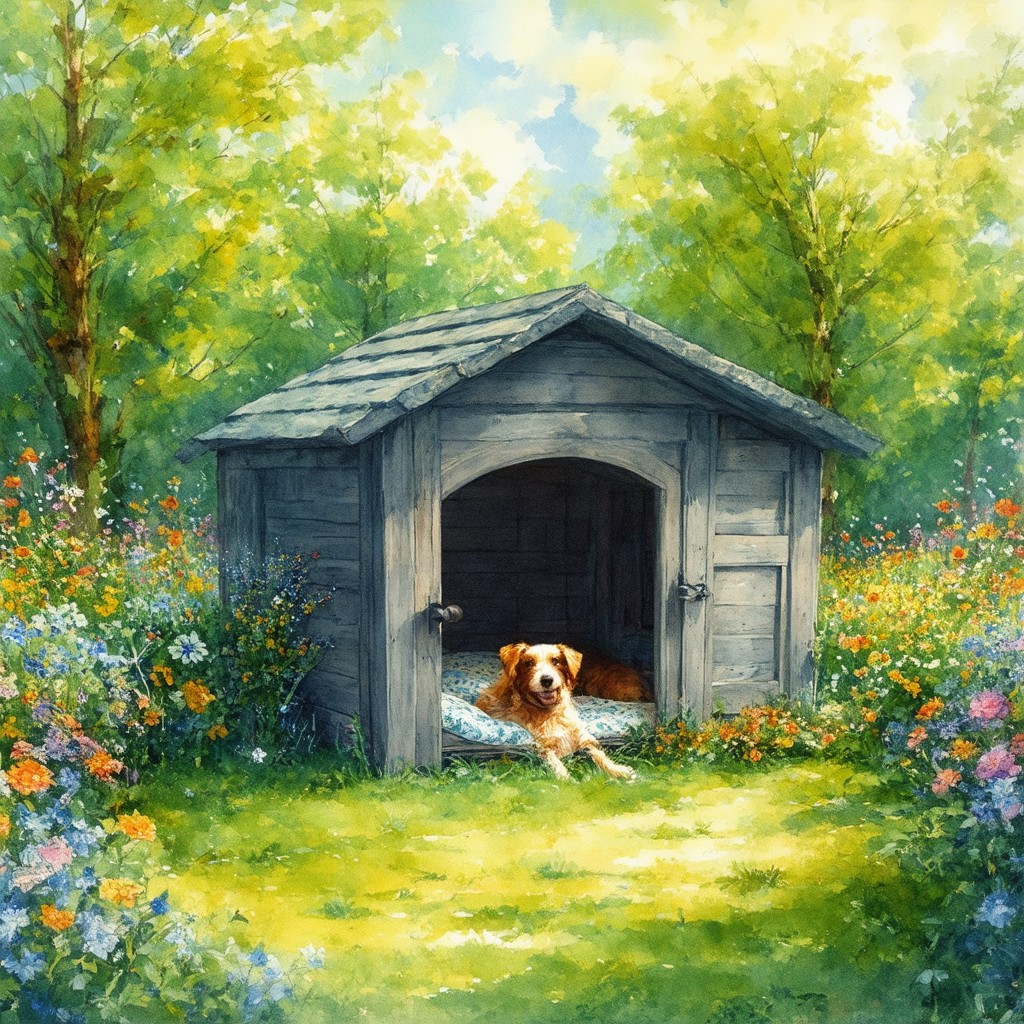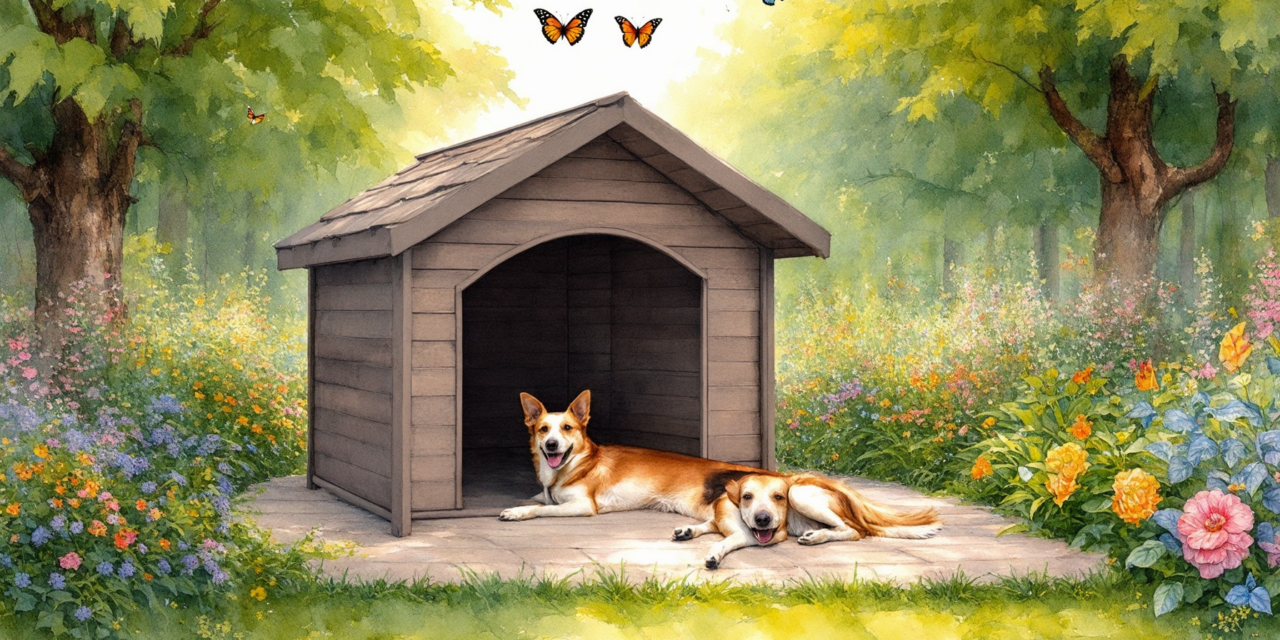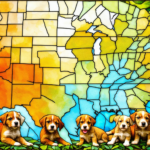Key Takeaways
- Safety First: Ensure your outdoor dog kennel provides protection from extreme weather and potential predators to keep your dog safe and secure.
- Ideal Location: Position the kennel in shaded, sheltered spots with dry ground to enhance your dog’s comfort and well-being.
- Regular Interaction: Limit kennel time to 4-6 hours; dogs need social interaction and exercise to prevent anxiety and promote health.
- Material Matters: Choose durable materials like metal or treated wood for your kennel to withstand outdoor conditions and ensure longevity.
- Temperature Awareness: Monitor weather conditions closely; provide adequate insulation and ventilation to protect against extreme temperatures.
- Comfort Features: Look for kennels with roofs and proper bedding to enhance your dog’s comfort while sleeping outside.
Choosing the right outdoor dog kennel for your canine companion is a crucial decision that impacts their safety, comfort, and overall well-being. In this article, we will explore essential considerations that every dog owner should keep in mind, including the safety of outdoor dog kennels, ideal placement for your dog kennel outdoor, and the best materials to ensure durability and comfort. We will also address common questions such as, “Is it OK to keep a dog in an outdoor kennel?” and “How long can a dog stay in an outdoor kennel?” By understanding these key factors, you can create a secure and inviting environment for your furry friend. Whether you’re looking for outdoor dog kennels for large dogs or seeking DIY ideas, this guide will provide valuable insights to help you make an informed choice.
Is it OK to keep dog in outdoor kennel?
Keeping a dog in an outdoor kennel can be a contentious issue, and several factors must be considered to ensure the well-being of your pet. Here are key points to consider:
Understanding the Safety of Outdoor Dog Kennels
Outdoor dog kennels must provide adequate shelter from extreme weather conditions, including heat, cold, rain, and snow. According to the American Kennel Club (AKC), dogs are susceptible to hypothermia and heatstroke, making it crucial to have a well-insulated and ventilated kennel. Additionally, outdoor kennels should be secure from potential dangers such as predators, other animals, and escape routes. The Humane Society emphasizes the importance of a sturdy structure that can withstand external threats.
Moreover, dogs are inherently social animals that thrive on interaction with humans and other pets. The ASPCA recommends that dogs not be left alone for extended periods, as isolation can lead to behavioral issues such as anxiety and depression. An outdoor kennel should not be a substitute for regular exercise and mental stimulation. Providing toys, safe chew items, and opportunities for play can help maintain your dog’s physical and mental health. Regular checks for signs of distress, illness, or injury are essential. Keeping a close eye on your dog’s behavior and health can prevent serious issues.
In conclusion, while it may be acceptable to use an outdoor kennel for short periods, it is not advisable to leave a dog alone overnight without proper precautions. For more detailed guidance on dog care and wellness, consider consulting resources from the AKC or the ASPCA.
Benefits of Using an Outdoor Dog Kennel
Utilizing an outdoor dog kennel can offer several benefits for both you and your pet. Here are some advantages to consider:
- Safe Space: An outdoor dog kennel provides a secure area for your dog to enjoy fresh air and sunshine while being protected from potential dangers.
- Controlled Environment: With an outdoor kennel, you can control your dog’s environment, ensuring they have a clean and safe space to relax.
- Reduced Indoor Mess: Keeping your dog in an outdoor kennel can help minimize indoor messes, especially for larger breeds that may require more space.
- Encourages Natural Behaviors: Outdoor kennels allow dogs to engage in natural behaviors such as barking, digging, and exploring, which can enhance their overall well-being.
- Convenience: An outdoor dog kennel can be a convenient option for pet owners who may not have the time to supervise their dogs constantly.
When selecting an outdoor dog kennel, consider options like an outdoor dog kennel with roof to provide additional protection from the elements. For more ideas on creating a suitable outdoor space for your pet, explore our dog kennel ideas.

Where Should I Put My Dog Kennel Outside?
Choosing the right location for your outdoor dog kennel is essential for your dog’s comfort and safety. A well-placed outdoor dog kennel can enhance your pet’s well-being and ensure they enjoy their time outside. Here are some key factors to consider when deciding where to place your dog kennel:
- Shade and Shelter: Position the kennel in an area that provides ample shade during the hottest parts of the day. Trees, shrubs, or a covered patio can help protect your dog from direct sunlight, reducing the risk of overheating. According to the American Kennel Club, dogs can suffer from heatstroke, so ensuring a cool environment is crucial.
- Wind Protection: Avoid placing the kennel in open areas where strong winds can create discomfort or even pose a danger to your dog. A sheltered spot, such as near a fence or wall, can help shield your dog from harsh weather conditions.
- Dry Ground: Ensure the kennel is placed on dry, elevated ground to prevent water accumulation during rain. A well-drained area helps keep your dog dry and comfortable, reducing the risk of health issues related to dampness.
- Visibility and Interaction: Dogs are social animals and thrive on interaction. Placing the kennel in a location where your dog can see family activities can help reduce anxiety and loneliness. This could be near a frequently used entrance or patio.
- Safety from Pests: Choose a location that minimizes exposure to pests such as ticks, fleas, and mosquitoes. Keeping the kennel away from dense vegetation can help reduce the risk of infestations.
- Accessibility for Cleaning: Ensure the kennel is easily accessible for regular cleaning and maintenance. A location that allows for easy access will help you keep the kennel hygienic, which is essential for your dog’s health.
- Local Regulations: Check local zoning laws and regulations regarding outdoor pet housing. Some areas may have specific requirements for kennel placement that you need to follow.
By considering these factors, you can create a safe and comfortable outdoor environment for your dog. For more detailed guidance on dog care and kennel placement, refer to resources from the American Kennel Club and the Humane Society.
Ideal Locations for Your Outdoor Dog Kennel
When selecting the ideal location for your dog kennel outdoor, consider these optimal spots:
- Near the House: Placing the kennel close to your home allows your dog to feel secure and connected to the family. It also makes it easier for you to monitor your pet.
- Partially Shaded Areas: Look for spots that receive partial shade throughout the day, helping to regulate your dog’s temperature and providing a comfortable resting place.
- Fenced Areas: If possible, place the kennel within a fenced area to provide additional security and prevent your dog from wandering off.
- Quiet Zones: Choose a location away from loud noises or heavy foot traffic to help your dog feel more relaxed and secure.
By carefully selecting the right location for your outdoor dog kennel, you can ensure your pet enjoys a safe and comfortable outdoor experience.
Factors to Consider When Placing Your Dog Kennel
In addition to the ideal locations, consider these important factors when placing your outdoor dog kennels:
- Weather Conditions: Assess the typical weather in your area. Ensure the kennel is placed to protect your dog from extreme heat, cold, and precipitation.
- Ground Stability: Ensure the ground is stable and free from hazards like sharp objects or uneven surfaces that could harm your dog.
- Accessibility for Supplies: Consider how easy it will be to access the kennel for feeding, cleaning, and maintenance. A convenient location can save you time and effort.
- Future Expansion: If you plan to add more pets or expand your outdoor space, consider how the kennel’s location will fit into your future plans.
By taking these factors into account, you can create a safe and enjoyable outdoor space for your dog, ensuring they thrive in their outdoor dog kennel.
How long can a dog stay in an outdoor kennel?
When considering how long a dog can stay in an outdoor kennel, it’s essential to prioritize their well-being. Generally, dogs should not be left in a kennel for more than 4 to 6 hours at a time during the day. Puppies and senior dogs may require even shorter durations due to their specific needs. Here are some key considerations:
- Potty Breaks: Dogs need regular potty breaks to avoid discomfort and potential health issues. A good rule of thumb is that dogs can hold their bladder for about one hour for every month of age, up to about 8 hours for adult dogs.
- Social Interaction: Dogs are social animals and require interaction to prevent anxiety and behavioral issues. Prolonged isolation can lead to stress and loneliness.
- Exercise Requirements: Daily exercise is essential for a dog’s physical and mental health. A lack of exercise can lead to obesity and other health problems. Aim for at least 30 minutes to 2 hours of exercise daily, depending on the breed and age.
- Weather Conditions: Ensure that the kennel is safe and comfortable, providing adequate shelter from extreme temperatures, rain, or direct sunlight. Dogs are sensitive to heat and cold, and prolonged exposure can be harmful.
- Kennel Size and Environment: The kennel should be spacious enough for the dog to stand, turn around, and lie down comfortably. It should also be clean and free from hazards.
For more detailed guidance on dog care, including kennel usage, consult resources from the American Kennel Club (AKC) and the Humane Society. These organizations provide comprehensive information on responsible pet ownership and care practices.
Signs Your Dog Needs to Come Inside
Recognizing when your dog needs to come inside from their outdoor kennel is crucial for their health and happiness. Here are some signs to watch for:
- Excessive Barking or Whining: If your dog is vocalizing more than usual, it may indicate they are feeling anxious or uncomfortable.
- Restlessness: Dogs that are pacing or unable to settle down may need a change of environment or more interaction.
- Seeking Shelter: If your dog is trying to find shade or shelter from the elements, it’s a clear sign they are uncomfortable and need to come inside.
- Signs of Stress: Look for signs such as panting, drooling, or destructive behavior, which can indicate that your dog is stressed and needs to be indoors.
- Weather Changes: Be mindful of sudden changes in weather, such as rain or extreme heat, which can make outdoor conditions unsafe for your dog.
By being attentive to these signs, you can ensure your dog remains comfortable and healthy while using their outdoor dog kennel. For more tips on outdoor dog kennels, check out our dog kennel ideas.
What is the Best Material for Outdoor Dog Kennels?
When selecting the best material for outdoor dog kennels, it’s essential to consider durability, safety, and protection from environmental elements. Here are the top materials recommended for outdoor dog kennels:
- Metal:
- Metal kennels, particularly those made from galvanized steel or aluminum, are highly durable and resistant to rust and corrosion. They provide a secure environment as they eliminate gaps that dogs could exploit to escape. Additionally, metal kennels offer excellent protection against harsh weather conditions, including wind, rain, snow, and intense sunlight. According to a study published in the Journal of Animal Science, metal structures can significantly enhance the safety and well-being of dogs in outdoor settings.
- Wood:
- Wooden kennels, especially those made from cedar or treated pine, are aesthetically pleasing and provide good insulation. They can keep dogs warm in winter and cool in summer. However, it’s crucial to ensure that the wood is treated to resist rot and pests. The American Kennel Club (AKC) recommends regular maintenance to prolong the life of wooden kennels.
- Plastic:
- High-density polyethylene (HDPE) plastic kennels are lightweight, easy to clean, and resistant to moisture and UV rays. They are a good option for portability and can be an excellent choice for temporary setups. According to the American Society for the Prevention of Cruelty to Animals (ASPCA), plastic kennels can provide adequate shelter if properly ventilated.
- Composite Materials:
- Composite kennels combine materials like wood and plastic to offer the benefits of both. They are often designed to be weather-resistant and require less maintenance than traditional wood kennels. Research from the Pet Industry Federation indicates that composite materials can enhance the longevity and durability of outdoor kennels.
- Chain Link Fencing:
- While not a standalone kennel material, chain link fencing is often used in conjunction with other materials to create secure outdoor spaces for dogs. It allows for visibility and ventilation while keeping dogs contained. The Humane Society emphasizes the importance of using sturdy, high-quality chain link to prevent escapes.
- Fabric:
- Heavy-duty fabric kennels are portable and can be a good option for travel or temporary use. However, they may not provide the same level of protection as more solid materials. The AKC advises that fabric kennels should be used in safe environments where dogs cannot easily escape or be harmed.
In conclusion, the best material for outdoor dog kennels depends on your specific needs, including the climate, the dog’s size and behavior, and your budget. For optimal safety and comfort, consider a combination of materials that provide durability, insulation, and protection from the elements. Always consult with a veterinarian or a pet care expert for personalized recommendations based on your dog’s needs.
Heavy Duty Outdoor Dog Kennel with Roof Options
When considering a heavy-duty outdoor dog kennel, opting for a model with a roof can significantly enhance your dog’s comfort and safety. A roof provides essential protection from the elements, including rain, snow, and direct sunlight, ensuring your dog remains dry and cool. Here are some key features to look for in a heavy-duty outdoor dog kennel with roof options:
- Material Quality: Look for kennels made from robust materials like galvanized steel or high-quality wood that can withstand harsh weather conditions.
- Ventilation: Ensure the kennel has adequate ventilation to keep your dog comfortable, especially during warmer months.
- Size: Choose a kennel that offers enough space for your dog to move around comfortably. Large outdoor dog kennels are ideal for bigger breeds.
- Security Features: Check for secure locking mechanisms and sturdy construction to prevent escapes and protect against potential predators.
- Easy Maintenance: Select a kennel that is easy to clean and maintain, which will help keep your dog healthy and happy.
For those interested in purchasing a heavy-duty outdoor dog kennel with a roof, options are available at retailers like Tractor Supply Company and Chewy. These kennels not only provide safety but also enhance your dog’s outdoor experience.

Is it OK for dogs to sleep outside in a kennel?
Yes, it is generally acceptable for dogs to sleep outside in a kennel, provided certain conditions are met to ensure their safety, comfort, and well-being. Here are key considerations:
- Kennel Quality: Ensure the kennel is well-constructed, insulated, and weatherproof. It should be large enough for your dog to stand, turn around, and lie down comfortably. A raised floor can help keep your dog dry and warm.
- Temperature Control: Dogs are sensitive to extreme temperatures. In cold weather, provide bedding such as straw or blankets to keep them warm. In hot weather, ensure the kennel is shaded and has proper ventilation to prevent overheating.
- Safety and Security: The kennel should be secure from predators and escape. Regularly check for any potential hazards, such as sharp objects or toxic plants nearby.
- Social Interaction: Dogs are social animals and require interaction with their owners. Ensure that your dog spends quality time with you and is not isolated for long periods.
- Health Considerations: Monitor your dog’s health regularly. If your dog shows signs of distress or discomfort while outside, it may be necessary to bring them indoors.
- Legal and Community Guidelines: Check local regulations regarding outdoor dog housing, as some areas have specific laws about keeping pets outside.
- Veterinary Advice: Consult with a veterinarian for personalized recommendations based on your dog’s breed, age, and health status.
By following these guidelines, you can create a safe and comfortable outdoor environment for your dog. For more detailed information on dog care and well-being, resources such as the American Kennel Club (AKC) and the Humane Society provide valuable insights.
Comfort Considerations for Dogs Sleeping Outside
When allowing your dog to sleep outside in an outdoor dog kennel, comfort is paramount. Here are some factors to enhance your dog’s sleeping experience:
- Bedding: Use appropriate bedding materials like straw, blankets, or specialized dog beds designed for outdoor use. This helps insulate against cold and provides a comfortable resting place.
- Protection from Elements: Consider an outdoor dog kennel with roof to shield your dog from rain, snow, and direct sunlight, ensuring they remain dry and comfortable.
- Ventilation: Ensure the kennel has proper airflow to prevent overheating during warmer months. Ventilated designs can help maintain a comfortable temperature.
- Regular Checks: Frequently check on your dog to ensure they are comfortable and safe. This also allows you to address any issues that may arise, such as discomfort or health concerns.
Outdoor Dog House Options for Added Comfort
Choosing the right dog house can significantly impact your dog’s comfort when sleeping outside. Here are some options to consider:
- Insulated Dog Houses: Look for insulated models that provide warmth during colder months. These houses often feature raised floors and weatherproof materials.
- Heated Dog Houses: For extreme cold, consider a dog house with heater to ensure your pet stays warm and cozy.
- Customizable Options: Explore Tractor Supply Company for customizable outdoor dog houses that can be tailored to your dog’s size and needs.
- Portable Dog Houses: If you travel often, a portable outdoor dog house can provide a familiar and comfortable space for your dog, no matter where you go.
What temperature is too cold for dogs?
Understanding temperature safety for outdoor dogs is crucial for their well-being. Individual tolerance to cold varies based on factors such as breed, age, health, and coat type. Generally, temperatures below 0°C (32°F) can pose risks to many dogs, while temperatures around -4°C (25°F) and lower can be particularly hazardous.
Understanding Temperature Safety for Outdoor Dogs
- Small Breeds and Short-Haired Dogs: Breeds like Chihuahuas and Greyhounds, with less body fat and shorter coats, may start to feel uncomfortable in temperatures as high as 7°C (45°F). Prolonged exposure to cold can lead to hypothermia or frostbite.
- Medium to Large Breeds: Dogs such as Labrador Retrievers and Golden Retrievers, which have thicker coats, can tolerate colder temperatures, but caution is still advised. It’s best to limit outdoor activities when temperatures drop below -4°C (25°F).
- Senior and Ill Dogs: Older dogs or those with health issues may have a reduced ability to regulate their body temperature. For these dogs, it’s advisable to keep them indoors when temperatures fall below 0°C (32°F).
- Signs of Cold Stress: Watch for signs of discomfort in your dog, including shivering, whining, or reluctance to walk. If you notice these behaviors, it’s crucial to bring your dog indoors to warm up.
- Precautionary Measures: When walking your dog in cold weather, consider using dog sweaters or coats, and limit the duration of walks. Always ensure your dog has access to fresh water and a warm place to rest.
According to the American Kennel Club, understanding your dog’s specific needs and monitoring their behavior in cold weather is key to ensuring their safety. For more detailed guidance on keeping your dog healthy in varying temperatures, consult resources from veterinary professionals or organizations like the ASPCA.
Outdoor Dog Kennel Heater Solutions
To ensure your dog remains comfortable in colder temperatures, consider investing in outdoor dog kennel heater solutions. Options such as dog house heaters and outdoor dog house heaters can provide the necessary warmth for your pet. Additionally, an outdoor dog kennel with roof can offer protection from the elements while maintaining a cozy environment.
When selecting a heater, ensure it is designed for outdoor use and safe for pets. Look for models that are energy-efficient and have safety features to prevent overheating. This way, you can create a warm and secure space for your dog, even during the coldest months.
Choosing the Right Outdoor Dog Kennel for Your Needs
When selecting an outdoor dog kennel, it’s essential to consider your dog’s size, breed, and specific needs. The right kennel not only provides a safe space for your pet but also enhances their comfort and well-being. Here are some key factors to keep in mind.
Outdoor Dog Kennels for Large Dogs: What to Look For
For large breeds, choosing an outdoor dog kennel for large dogs is crucial. Here are some features to consider:
- Size: Ensure the kennel is spacious enough for your dog to stand, turn around, and lie down comfortably. A large outdoor dog kennel typically measures at least 10×10 feet.
- Material: Opt for durable materials like galvanized steel or heavy-duty plastic that can withstand outdoor elements.
- Roof Options: Consider an outdoor dog kennel with roof to protect your dog from rain and sun.
- Flooring: Look for kennels with proper flooring or consider adding dog kennel flooring to keep your dog comfortable and dry.
DIY Outdoor Dog Kennel Ideas and Plans
If you’re considering a more personalized approach, creating a DIY outdoor dog kennel can be a rewarding project. Here are some ideas and plans to get you started:
- Homemade Designs: Use materials like wood, chain link, or even repurposed pallets to build a sturdy structure. Ensure it has adequate ventilation and protection from the elements.
- Custom Features: Incorporate features like a dog house heater for colder climates or a shaded area for hot days.
- Space Planning: Design the kennel layout to include a separate area for a dog house, ensuring your pet has a cozy retreat.
- Safety Measures: Use secure fencing and consider adding a dog run fence to provide additional space for exercise.












